
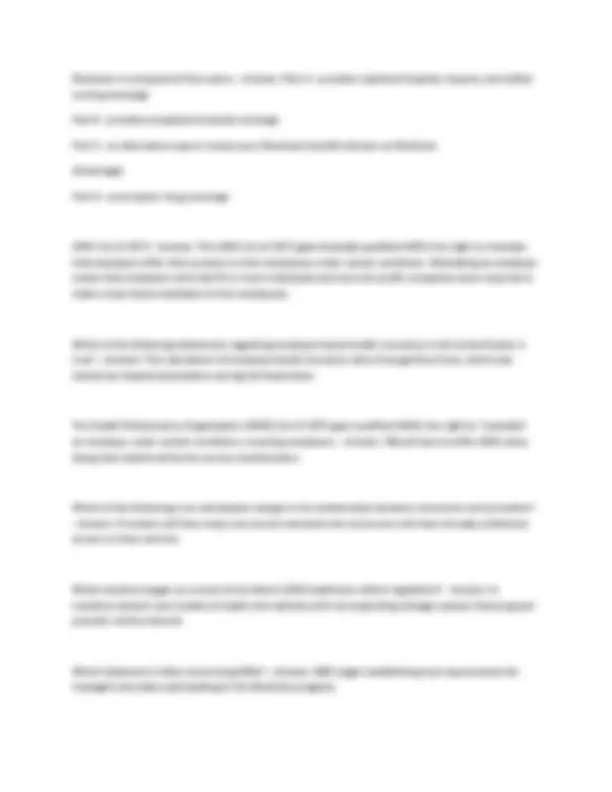
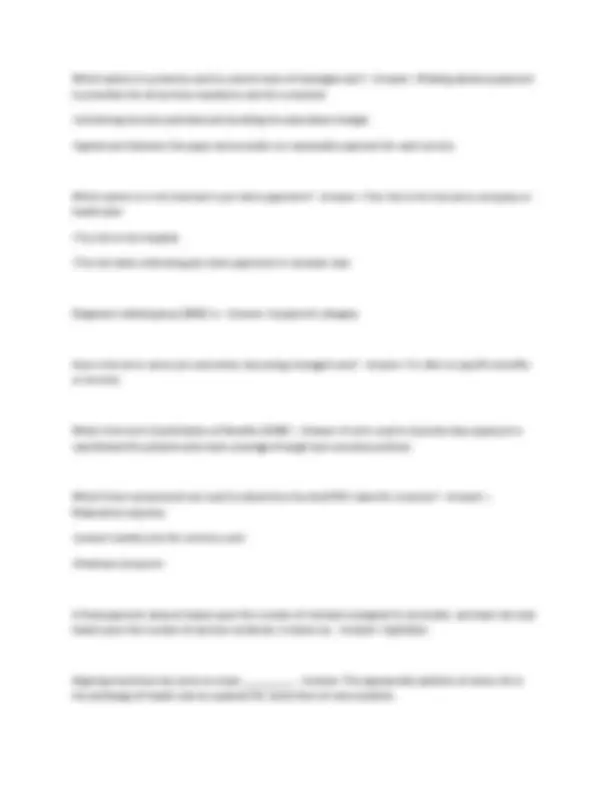

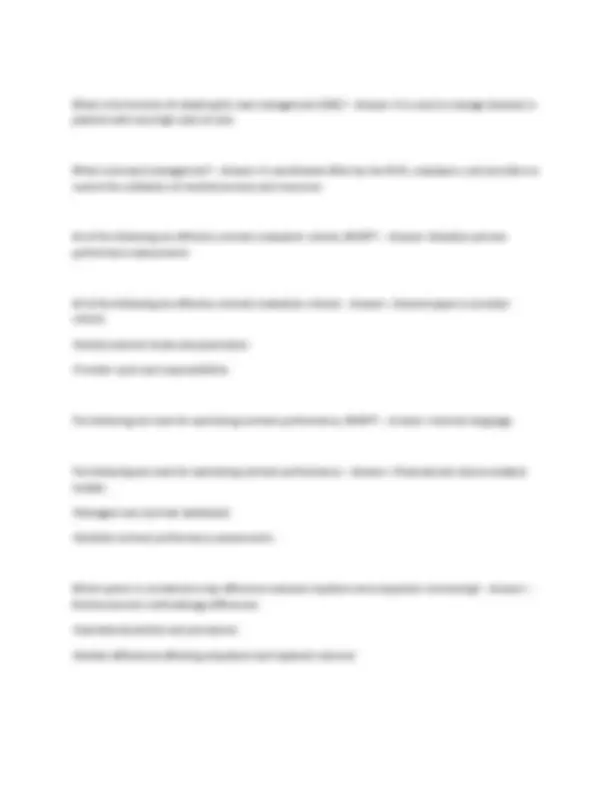

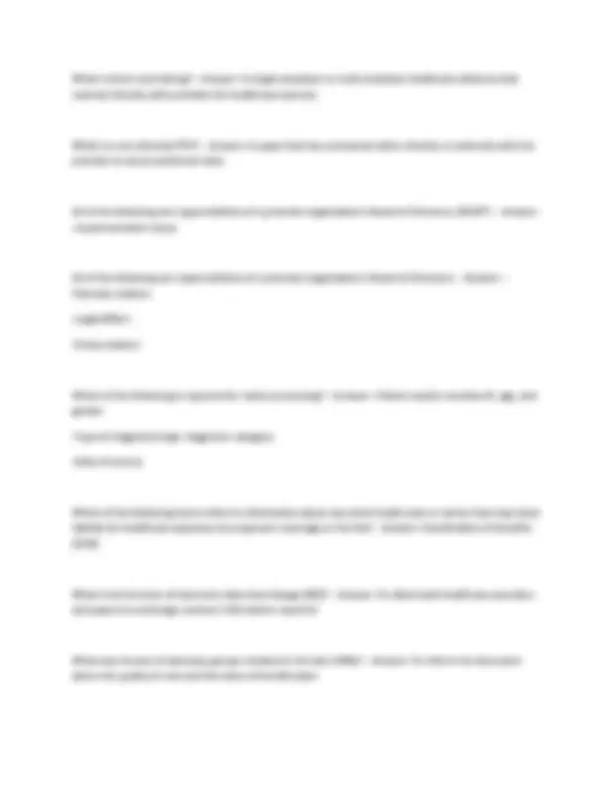
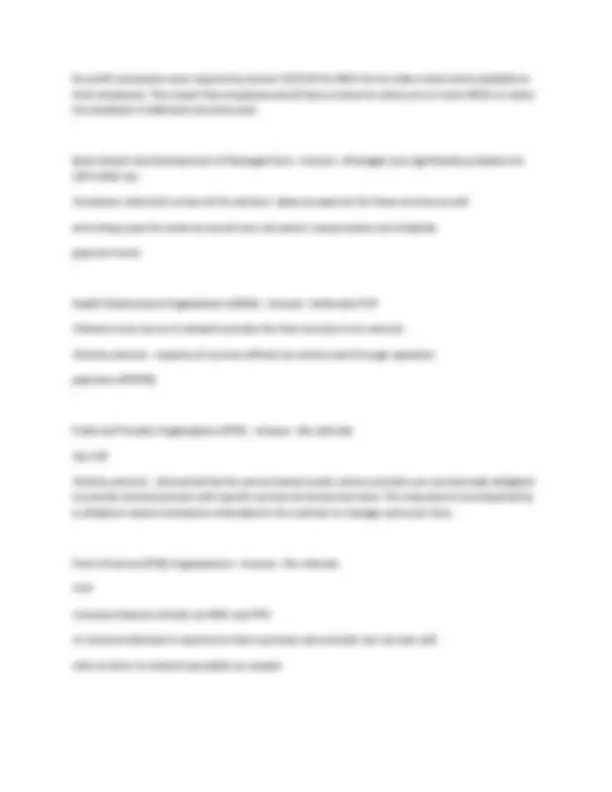
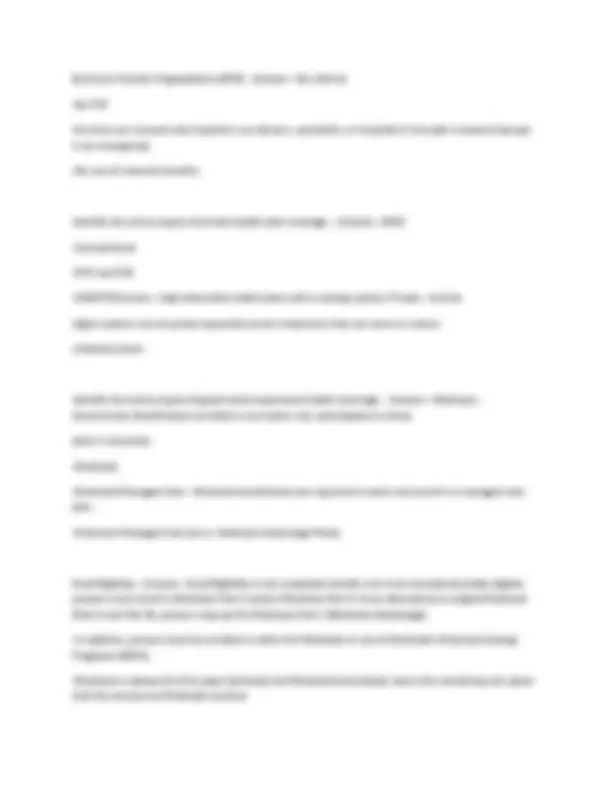
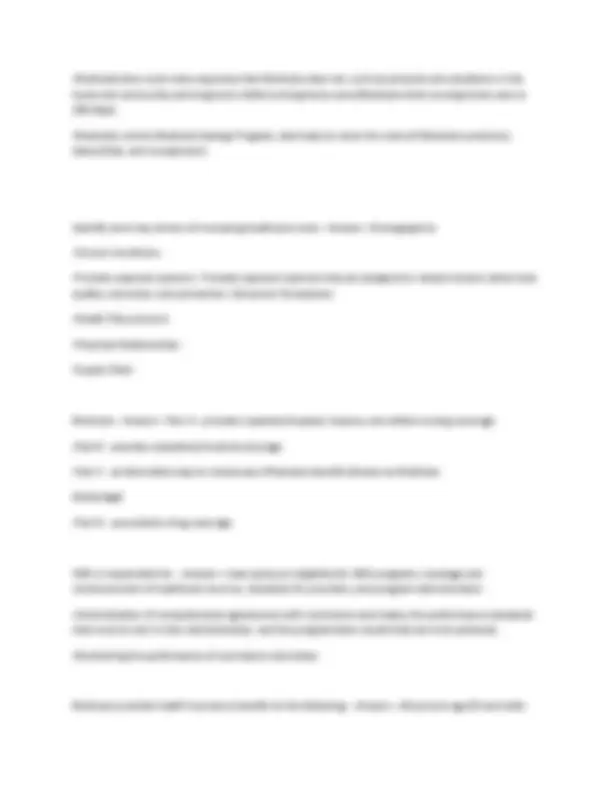
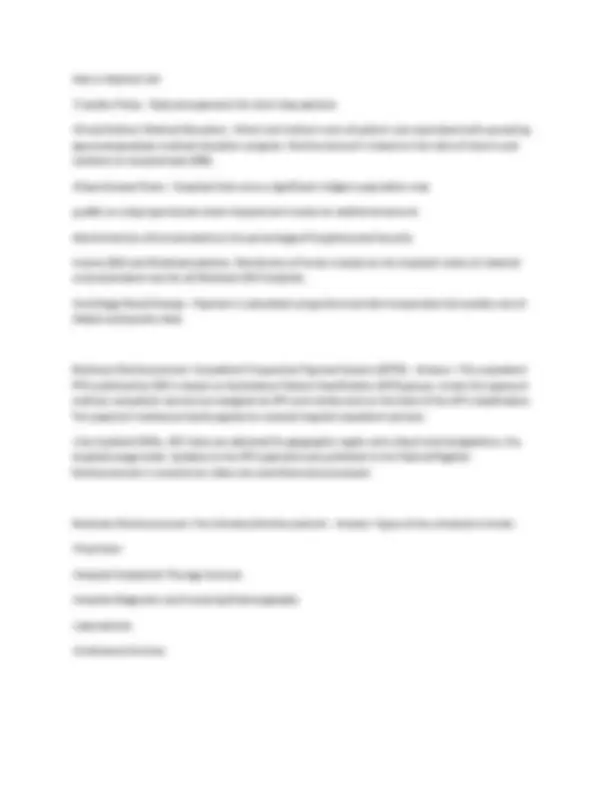

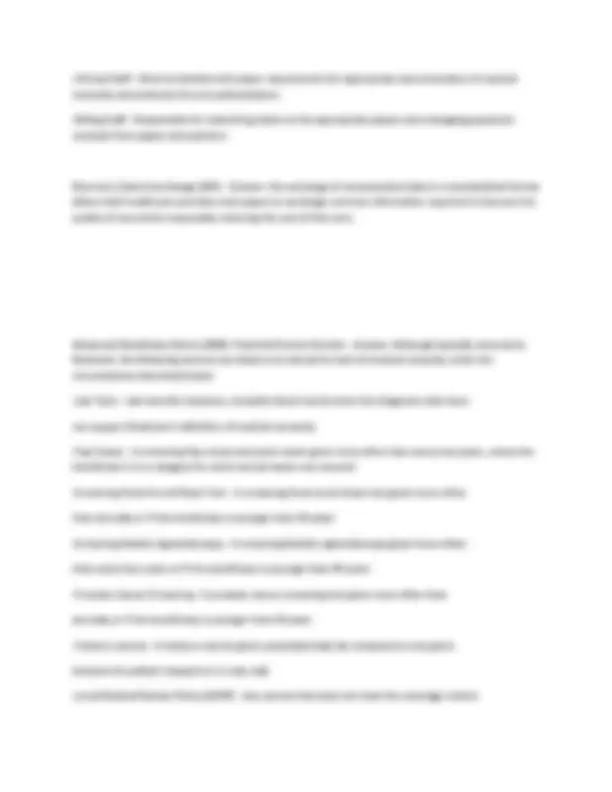
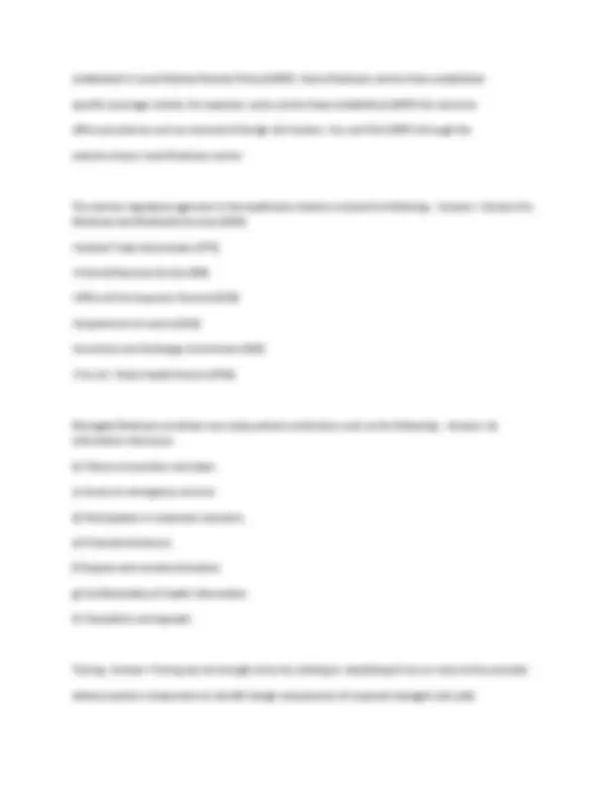
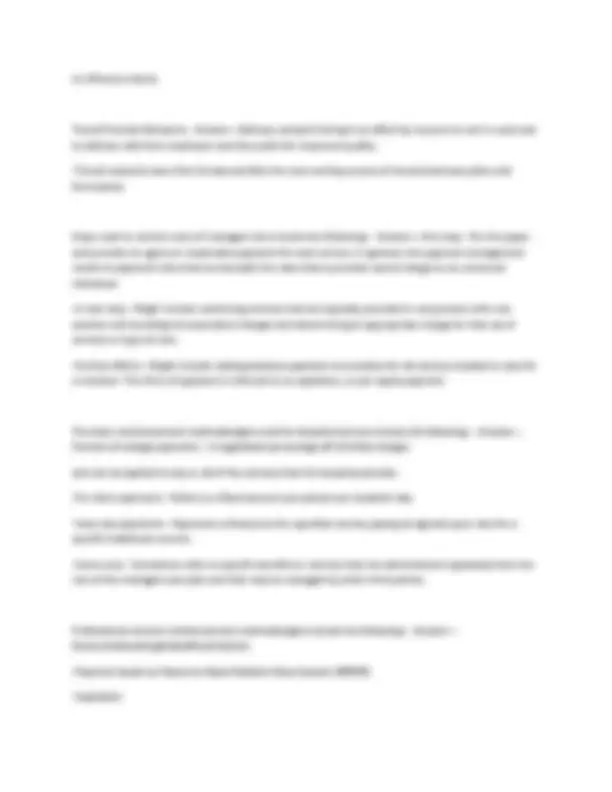
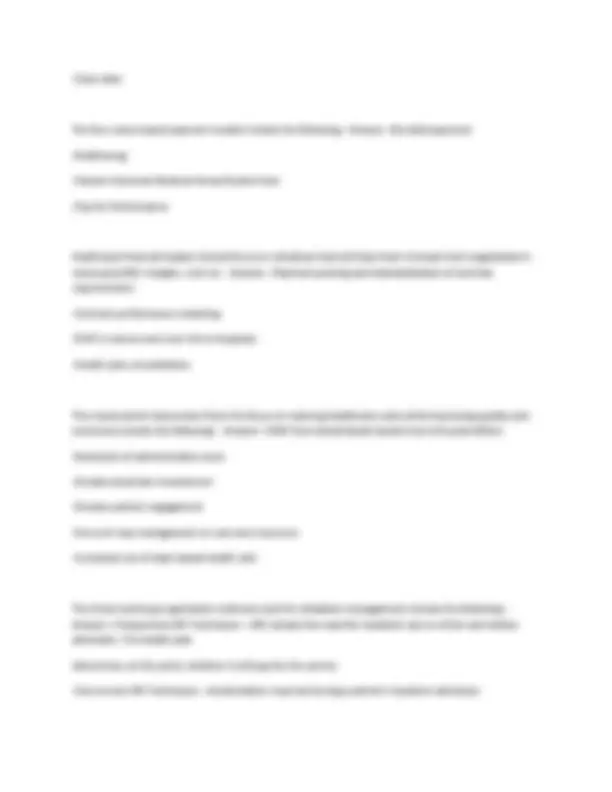
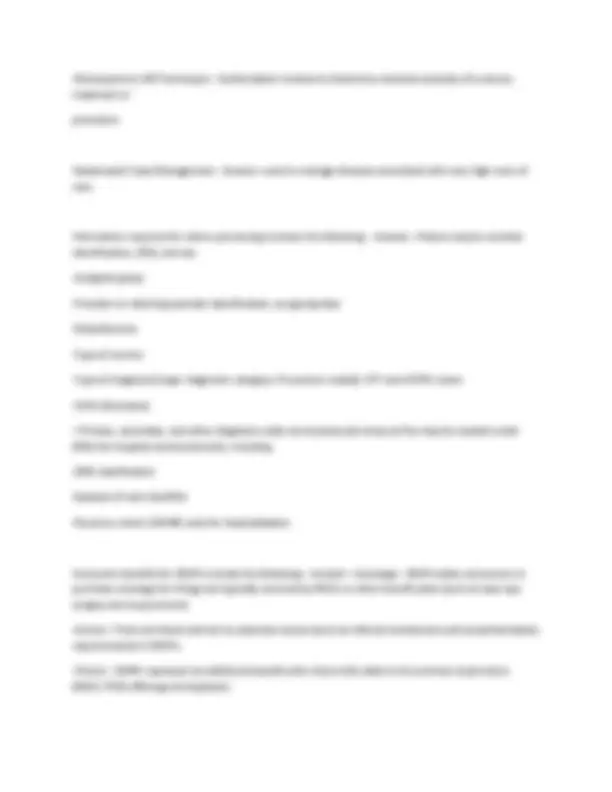
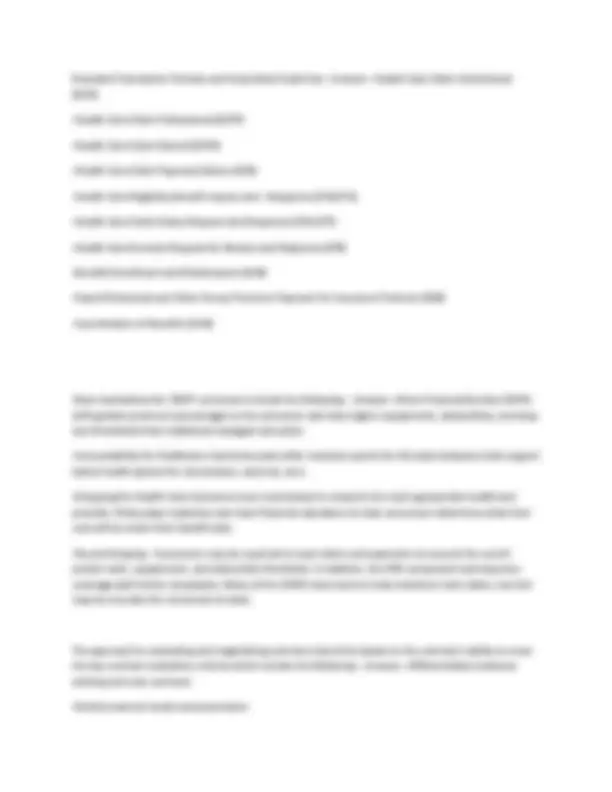
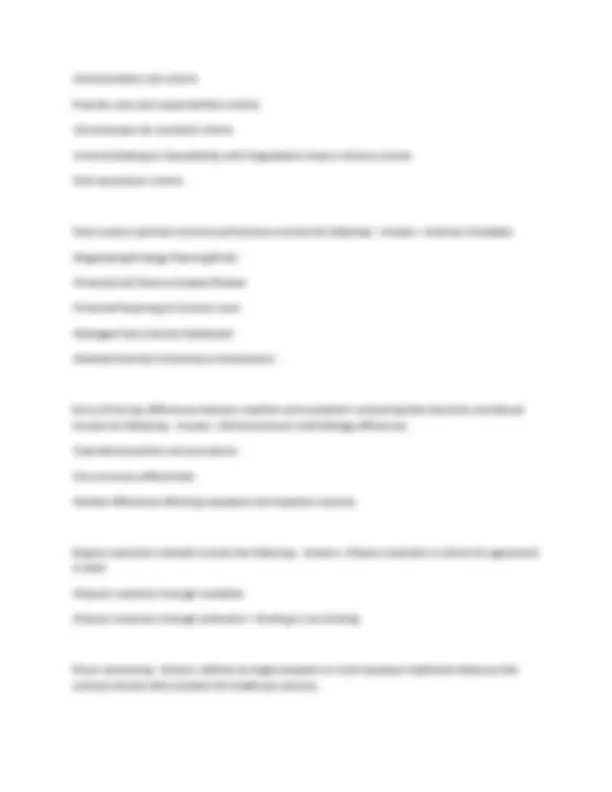



Study with the several resources on Docsity

Earn points by helping other students or get them with a premium plan


Prepare for your exams
Study with the several resources on Docsity

Earn points to download
Earn points by helping other students or get them with a premium plan
Community
Ask the community for help and clear up your study doubts
Discover the best universities in your country according to Docsity users
Free resources
Download our free guides on studying techniques, anxiety management strategies, and thesis advice from Docsity tutors
Questions and answers for the HFMA's Certified Specialist Payment Representative (CSPR) exam for 2025/2026. Key topics include managed care cost control, reimbursement methodologies (DRG, capitation), private and government health coverage (HMO, PPO, Medicare, Medicaid), healthcare cost drivers, and healthcare organizations (MCO, TPA, PSO). It also covers healthcare reform, ABNs, medical cost ratios, contract evaluation, and utilization management. This study guide for healthcare payment professionals offers insights into healthcare management's financial and operational aspects. It helps candidates prepare for the CSPR exam with verified, graded answers, ensuring a thorough understanding. It also explores employer-based health insurance and legislation like the HMO Act of 1973.
Typology: Exams
1 / 27

This page cannot be seen from the preview
Don't miss anything!




















Steps used to control costs of managed care include: - Answer--Bundled codes
Capitation
Payer and Provider to agree on reasonable payment
DRG is used to classify - Answer--Inpatient admissions for the purpose of reimbursing hospitals for each case in a given category w/a negotiated fixed fee, regardless of the actual costs incurred
Identify the various types of private health plan coverage - Answer--HMO
Conventional
PPO and POS
HDHP/SO plans - high-deductible health plans with a savings option; Private - Include higher patient out- of-pocket expenditures for treatments that can serve to reduce utilization/costs.
Managed care organizations (MCO) exist primarily in four forms: - Answer--Health Maintenance Organizations (HMO)
Preferred Provider Organizations (PPO)
Point of Service (POS) Organizations
Exclusive Provider Organizations (EPO)
Identify the various types of government‐sponsored health coverage: - Answer--Medicare - Government; Beneficiaries enrolled in such plans, but, participation in these
plans is voluntary.
Medicaid
Medicaid Managed Care - Medicaid beneficiaries are required to select and enroll in a managed care plan.
Medicare Managed Care (a.k.a. Medicare Advantage Plans)
Identify some key drivers of increasing healthcare costs - Answer--Demographics
Chronic Conditions
Provider payment systems - Provider payment systems that are designed to reward volume rather than quality, outcomes, and prevention
Consumer Perceptions
Health Plan pressure
Physician Relationships
Supply Chain
Health Maintenance Organizations (HMO) - Answer--Referrals
PCP
Patients must use an in-network provider for their services to be covered.
Reimbursement - majority of services offered are reimbursed through capitation payments (PMPM)
Which option is a practice used to control costs of managed care? - Answer---Making advance payment to providers for all services needed to care for a member
-Combining services provided and bundling the associated charges
-Agreement between the payer and provider on reasonable payment for each service.
Which option is a risk involved in per diem payments? - Answer---The risk to the insurance company or health plan
-The risk to the hospital
-The risk when embracing per diem payments in complex case
Diagnosis-related group (DRG) is: - Answer--A payment category
How is the term carve-out used when discussing managed care? - Answer--To refer to specific benefits or services
What is the term Coordination of Benefits (COB)? - Answer--A term used to describe how payment is coordinated for patients who have coverage through two insurance policies
Which three components are used to determine the total RVU value for a service? - Answer--- Malpractice expense
-Lowest market price for services used
-Medicare discounts
A fixed payment amount based upon the number of members assigned to a provider, and does not vary based upon the number of services rendered, is known as: - Answer--Capitation
Aligning incentives has come to mean _________. - Answer--The appropriate addition of some risk in the exchange of health care to a patient for some form of remuneration.
According to MedPAC, which option is a benefit or undesirable consequence of bundling
payments? - Answer---It allows Medicare to pay a set fee per hospitalization episode.
-It would provide the potential to improve efficiency and quality
-It would lead to underutilization of services
As the healthcare industry moves to control growth in medical spending, what initiative can help hospitals maintain their margins? - Answer--Contract standardization
Which Statement is TRUE concerning ABNs? - Answer---ABNs are not required for services that are never covered by Medicare.
-An ABN form notifies the patient before he or she receives the service that it may not be
covered by Medicare and that he or she will need to pay out of pocket.
-Although ABNs can have significant financial implications for the physician, they also
serve an important fraud and abuse compliance function.
What is the overall function of Medicaid? - Answer--The pay for medical assistance for certain individuals and low-income families
Medical Cost Ratio (MCR) or Medical Loss Ratio (MLR) is defined as: - Answer--Total Medical Expenses divided by Total Premiums
Provider service organizations (PSOs) function like health maintenance organizations (HMOs) in all of the following ways, EXCEPT: - Answer--Ties to the healthcare delivery industry rather than the insurance industry
What is the role of reinsurance? - Answer--Reinsurance seeks to limit a policyholder's liability for catastrophic claims
Which option is a major trend in case management? - Answer---Shift from broad-based toward more focused efforts
-Reduction of administrative costs
-Greater physician involvement
What type of provider authorization is applied in emergency cases, where prior authorization is impossible? - Answer--Concurrent
What is utilization management (UM)? - Answer--A tool to control the costs of providing healthcare services to enrollees
Which of the following statements is true about disease management (DM)? - Answer--DM programs encourage patients to assume some control over their disease state
What is the purpose of the comprehension accreditation process? - Answer--To evaluate an organization's compliance with the CMS COP standards and other accreditation requirements
What was the aim of the HMO Act of 1973? - Answer--To change the system of health care delivery.
To be eligible for COBRA coverage, an employee must have: - Answer--Been enrolled in an employer's health plan while working and the health plan must continue to be in effect for active employees.
What is the purpose of Consolidated Omnibus Budget Reconciliation Act (COBRA) legislation? - Answer-- To provide continuation of group health coverage that otherwise might be terminated
What is the function of catastrophic case management (CM)? - Answer--It is used to manage diseases in patients with very high costs of care.
What is demand management? - Answer--A coordinated effort by the MCO, employers, and providers to control the utilization of medical services and resources
All of the following are effective contract evaluation criteria, EXCEPT: - Answer--Detailed contract performance assessments
All of the following are effective contract evaluation criteria: - Answer---General payer or provider criteria
-Reimbursement levels and parameters
-Provider costs and responsibilities
The following are tools for optimizing contract performance, EXCEPT: - Answer--Contract language
The following are tools for optimizing contract performance: - Answer---Financial and volume analysis models.
-Managed care contract dashboard.
-Detailed contract performance assessments.
Which option is considered a key difference between inpatient and outpatient contracting? - Answer--- Reimbursement methodology differences
-Operational policies and procedures
-Market differences affecting outpatient and inpatient volumes
What is direct contracting? - Answer--A single-employer or multi-employer healthcare alliances that contract directly with providers for healthcare services
What is a non-directed PPO? - Answer--A payer that has contracted either directly or indirectly with the provider to access preferred rates
All of the following are responsibilities of a provider organization's Board of Directors, EXCEPT: - Answer- -Implementation issues
All of the following are responsibilities of a provider organization's Board of Directors: - Answer--- Fiduciary matters
-Legal affairs
-Policy matters
Which of the following is required for claims processing? - Answer---Patient and/or enrollee ID, age, and gender
-Type of diagnosis/major diagnostic category
-Date of service
Which of the following terms refers to information about any other health plan or carrier that may share liability for healthcare expenses via a spouse's coverage or the like? - Answer--Coordination of benefits (COB)
What is the function of electronic data interchange (EDI)? - Answer--To allow both healthcare providers and payers to exchange common information required
What was the aim of advocacy groups initiated in the late 1990s? - Answer--To inform the discussion about the quality of care and the value of benefit plans
Which of the following statements is true regarding The Leapfrog Group? - Answer--The Leapfrog Group was started in the late 1990s to engage consumers and clinicians in the discussion to improve care quality.
Which option is included in the set of new value propositions and tools that emerged in the early 2000s?
-Medical management philosophies based on retrospective evaluation of care, rather than prospective review and management.
-A proliferation of self-service technologies to reduce administrative costs.
Identify which option(s) is a benefit for CDHP consumers. - Answer---Coverage
-Choice
-Access
Identify which options are a benefit for HSA consumers. - Answer---It is transportable, allowing workers access from one job to the next.
-Both employees and employers can contribute pretax dollars to the qualified account.
-They are available to everyone, not just employees of small businesses or the self-
employed.
What is an ACO? - Answer--A system of providers and facilities that can work in concert to care for a given patient population
What is one purpose of the Emergency Medical Treatment and Active Labor Act (EMTALA)? - Answer--To govern when and how a patient presenting at a hospital may be refused treatment
for-profit companies were required by section 1310 of the HMO Act to make a dual choice available to their employees. This meant that employees would have a choice to select one or more HMOs or select the employer's traditional insurance plan.
Early Growth and Development of Managed Care - Answer---Managed care significantly predates the 1973 HMO Act.
-Employers deducted a share of the workers' salary as payment for these services as well
as funding a pool for what we would now call worker compensation and disability
payment funds.
Health Maintenance Organizations (HMO) - Answer---Referralso PCP
-Patients must use an in-network provider for their services to be covered.
-Reimbursement - majority of services offered are reimbursed through capitation
payments (PMPM)
Preferred Provider Organizations (PPO) - Answer---No referrals
-No PCP
-Reimbursement - discounted fee-for-service based model, where providers are contractually obligated to provide covered persons with specific services at discounted rates. This may also be accompanied by a utilization review mechanism embedded in the contract to manage costs over time.
Point of Service (POS) Organizations - Answer---No referrals
-PCP
-Combine features of both an HMO and PPO
-A covered individual is required to have a primary care provider but can also self-
refer to other in-network specialists as needed
Exclusive Provider Organizations (EPO) - Answer---No referral
-No PCP
-Services are covered only if patients use doctors, specialists, or hospitals in the plan's network (except in an emergency).
-No out-of-network benefits.
Identify the various types of private health plan coverage. - Answer---HMO
-Conventional
-PPO and POS
-(HDHP/SO) plans - high-deductible health plans with a savings option; Private - Include
higher patient out-of-pocket expenditures for treatments that can serve to reduce
utilization/costs
Identify the various types of government‐sponsored health coverage. - Answer---Medicare - Government; Beneficiaries enrolled in such plans, but, participation in these
plans is voluntary.
-Medicaid
-Medicaid Managed Care - Medicaid beneficiaries are required to select and enroll in a managed care plan.
-Medicare Managed Care (a.k.a. Medicare Advantage Plans)
Dual Eligibility - Answer---Dual Eligibility is not a separate benefit, but to be considered dually eligible, persons must enroll in Medicare Part A and/or Medicare Part B. As an alternative to original Medicare (Part A and Part B), persons may opt for Medicare Part C (Medicare Advantage).
-In addition, persons must be enrolled in either full Medicaid or one of Medicaid's Medicare Savings Programs (MSPs).
-Medicare is always the first payer (primary) and Medicaid (secondary) covers the remaining cost, given that the services are Medicaid covered.
-Individuals with permanent renal (kidney) failure, eligible for dialysis treatment
-Individuals with certain disabilities
Mcare Part A (Hospital Insurance) - Answer---covers most medically necessary hospital, skilled nursing facility, home
health, and hospice care services.
-It is free if you have worked and paid Social Security taxes for at least 40 calendar quarters (10 years); those who have worked and paid taxes for less than 40 calendar quarters (10 years) are required to pay a fee
Mcare Part B (Medical Insurance) - Answer--covers most medically necessary doctors' services, preventive care, durable medical equipment, hospital outpatient services, laboratory tests, x-rays, mental health care, and some home health and ambulance services. An additional monthly premium is paid for this coverage.
Mcare Part C (Advantage) - Answer---allows private health insurance companies to provide Medicare
benefits.
-These Medicare private health plans are known as Medicare Advantage Plans. These plans
must offer at least the same benefits as Original Medicare (those covered under Parts A and B) but can do so with different rules, costs, and coverage restrictions.
-Medicare Part C may also offer additional health coverage benefits; you typically obtain Part D as part of a Medicare Advantage benefits package. --You may pay a monthly premium for this coverage, in addition to your Part B
premium.
Mcare Part D (Prescription) - Answer---outpatient prescription drug insurance, was established by the Medicare Prescription Drug, Improvement, and Modernization Act (MMA) on January 1, 2006.
-Part D is provided only through private insurance companies that have contracts with the government—it is never provided directly by the government (like original Medicare is).
How is Mcare financed? - Answer---Part A - Accumulation of funds in the Part A trust fund (for Medicare Part A benefits) occurs through a 1.45% payroll tax on both employer and employee under the Social Security Act
-Part B - Accumulation of funds in the Part B trust fund occurs through the SMI Trust Fund made by Congressional authorizations and through premiums paid by enrollees.
-Part C - Not separately financed
-Part D - Financing for Part D comes from general revenues (71%), beneficiary premiums (16%), and state contributions (12%). The monthly premium paid by enrollees is set to cover 25.5% of the cost of standard drug coverage. Medicare subsidizes the remaining 74.5%, based on bids submitted by plans for their expected benefit payments. Higher-income Part D enrollees pay a larger share of standard Part D costs, ranging from 35% to 85%, depending on income.
Medicare Reimbursement - Answer---Inpatient Prospective Payment Systems (IPPS)
-Outpatient Prospective Payment System (OPPS)
-Medicare Payments to Physicians
Medicare Reimbursement: Inpatient Prospective Payment System (IPPS) - Answer---IPPS reimbursement provides for the cost of inpatient services, including capital costs.
o IPPS is a case rate paid based on the diagnosis related group (DRG)—and as of 2007, Medicare Severity DRG or MS-DRG—assigned to each case.
o The MS-DRG payment covers diagnostic services and most admission-related non- diagnostic services provided in the hospital outpatient department up to three calendar days prior to the admission (or one day for hospitals that are not paid under IPPS). This is commonly, although inaccurately, referred to as the "72-Hour Rule." (The rule is based on calendar days, not hours, and within healthcare is referred to as "the three-midnight rule".)
o DRG rates are adjusted for geographic region and urban/rural designations, known as the
hospital's wage index. Periodic updates to the DRG payment rates are published in the Federal Register.
Base MS-DRG payment, hospitals receive adjusted reimbursement for the following categories of costs: - Answer---Cost Outliers - Cost Outliers are defined as cases involving atypical lengths of
Medicare Reimbursement: Value-Based Purchasing and Quality Related Programs - Answer--Medicare introduced Value- Based Purchasing (VBP) programs designed to financially reward or penalize providers based on their performance related to cost, quality, and patient experience measures.
Medicare Secondary Payer Questionnaire (MSPQ) - Answer---Medicare requires that questionnaires be completed on patients receiving both inpatient and outpatient services.
-Frequency - Hospitals must be able to demonstrate that they collected MSP information from the beneficiary or his/her representative at the time of inpatient, outpatient and recurring outpatient services, no older than 90 days, when submitting bills for their Medicare patients.
-Questionnaire Retention - Providers must keep completed MSP questionnaire copies and other MSP information for 10 years after the service date. Providers may keep hard copy files, optical images, microfilms, or microfiches. When storing the files online, keep negative and positive question responses.
Medicare Outpatient Observation Notice (MOON) - Answer---requires hospitals and Critical Access Hospitals (CAH) to provide notification to individuals receiving observation services as outpatients for more than 24 hours explaining the status of the individual as an outpatient, not an inpatient, and the implications of such status.
-Requirements - The MOON must be provided no later than 36 hours after observation services are initiated or, if sooner, upon release. An oral explanation of the MOON must be provided, ideally in conjunction with the delivery of the notice, and a signature must be obtained from the individual, or a person acting on such individual's behalf, to acknowledge receipt. In cases where such individual or person refuses to sign the MOON, the staff member of the hospital or CAH providing the notice must sign the notice to certify that notification was presented.
PCMH model - Answer--a term used to describe a model of care in which primary care services are delivered to families in an accessible, continuous, comprehensive, and integrated fashion.
The specific roles and responsibility of each level within the small physician practice managed care infrastructure included the following: - Answer---Practice Manager ‐ Oversee all operational aspects of the practice, including managed care contracting.
Electronic Data Interchange (EDI) - Answer--the exchange of computerized data in a standardized format allows both healthcare providers and payers to exchange common information required to improve the quality of care while measurably reducing the cost of that care.
Advanced Beneficiary Notice (ABN): Potential Service Denials - Answer--Although typically covered by Medicare, the following services are likely to be denied for lack of medical necessity under the circumstances described below:
-Lab Tests - Lab tests (for example, complete blood count) when the diagnosis code does
not support Medicare's definition of medical necessity.
-Pap Smear - A screening Pap smear and pelvic exam given more often than every two years, unless the beneficiary is in a category for which annual exams are covered
-Screening Fecal Occult Blood Test - A screening fecal occult blood test given more often
than annually or if the beneficiary is younger than 50 years
-Screening flexible sigmoidoscopy - A screening flexible sigmoidoscopy given more often
than every four years or if the beneficiary is younger than 45 years
-Prostate Cancer Screening - A prostate cancer screening test given more often than
annually or if the beneficiary is younger than 50 years
-Tetanus vaccine - A tetanus vaccine given prophylactically (as compared to one given
because the patient stepped on a rusty nail)
-Local Medical Review Policy (LMRP) - Any service that does not meet the coverage criteria